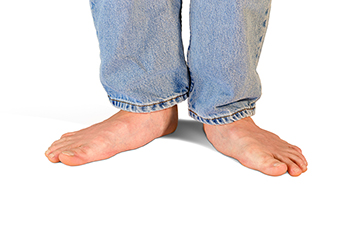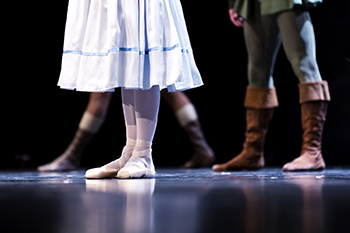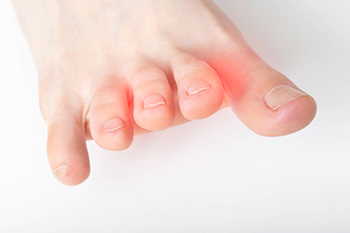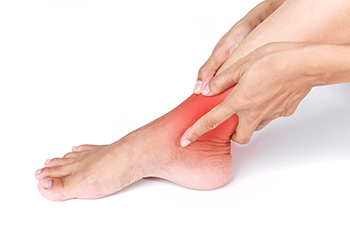Connect With Us
Blog
Items filtered by date: July 2023
How Flat Feet Affect Your Body

Flat feet can be easily recognized by the absence of an arch space while standing on the feet. Instead, the foot lies flat on the floor. Flat feet can lead to pain across the arch and heel, while ill-fitting shoes or exercising on hard surfaces may only make it worse. Because having flat feet can affect your movement, the chances of developing knee and hip pain can increase. Athletes with flat feet are at a higher risk of plantar fasciitis, Achilles tendonitis, and knee injuries. Fortunately, people with flat feet who are experiencing some type of pain can wear an orthotic device to correct the deficiency and improve their gait. A podiatrist can examine the feet to determine the severity of this condition and also test the way you walk to determine what type of proper orthotic device is right for you. This foot doctor will make a mold of your feet that perfectly mirrors their shape and builds an insole specifically for you. For more information on options to deal with flat feet, it is suggested that you make an appointment with a podiatrist.
Flatfoot is a condition many people suffer from. If you have flat feet, contact David Carmack, DPM from Texas. Our doctor will treat your foot and ankle needs.
What Are Flat Feet?
Flatfoot is a condition in which the arch of the foot is depressed and the sole of the foot is almost completely in contact with the ground. About 20-30% of the population generally has flat feet because their arches never formed during growth.
Conditions & Problems:
Having flat feet makes it difficult to run or walk because of the stress placed on the ankles.
Alignment – The general alignment of your legs can be disrupted, because the ankles move inward which can cause major discomfort.
Knees – If you have complications with your knees, flat feet can be a contributor to arthritis in that area.
Symptoms
- Pain around the heel or arch area
- Trouble standing on the tip toe
- Swelling around the inside of the ankle
- Flat look to one or both feet
- Having your shoes feel uneven when worn
Treatment
If you are experiencing pain and stress on the foot you may weaken the posterior tibial tendon, which runs around the inside of the ankle.
If you have any questions please feel free to contact our office located in Marble Falls, TX . We offer the newest diagnostic and treatment technologies for all your foot and ankle needs.
Are Bunions Affecting Your Everyday Life?
Dance Foot Injuries

Dance is a beautiful art form, but it can take a toll on the dancer’s feet. Foot injuries are common among dancers because of the repetitive and high-impact movements involved. One foot injury that many dancers experience is metatarsalgia or pain and inflammation in the balls of the feet. This condition can result from a variety of things, including excessive flexibility, repetitive stress on the metatarsal bones, improper technique, and inadequate footwear. A dancer can practice prevention techniques to maintain their health and the quality of their performance. Resting and strengthening the muscles on the bottom of the feet often help with inflammation and pain. An example of an exercise that is useful is toe scrunches, which involves pulling a towel across the floor inward with the toes. Adding cushioning to dance shoes and orthotics to regular shoes might reduce the damage this ailment has on the feet. If you are a dancer and are experiencing foot pain, it is suggested that you visit a podiatrist for an examination and treatment.
Ankle and foot injuries are common among athletes and in many sports. They can be caused by several problems and may be potentially serious. If you are feeling pain or think you were injured in a sporting event or when exercising, consult with David Carmack, DPM from Texas. Our doctor will assess your condition and provide you with quality foot and ankle treatment.
Common Injuries
The most common injuries that occur in sporting activities include:
- Achilles Tendonitis
- Achilles Tendon Rupture
- Ankle Sprains
- Broken Foot
- Plantar Fasciitis
- Stress Fractures
- Turf Toe
Symptoms
Symptoms vary depending upon the injury and in some cases, there may be no symptoms at all. However, in most cases, some form of symptom is experienced. Pain, aching, burning, bruising, tenderness, tightness or stiffness, sensation loss, difficulty moving, and swelling are the most common symptoms.
Treatment
Just as symptoms vary depending upon the injury, so do treatment options. A common treatment method is known as the RICE method. This method involves rest, applying ice, compression and elevating the afflicted foot or ankle. If the injury appears to be more serious, surgery might be required, such as arthroscopic or reconstructive surgery. Lastly, rehabilitation or therapy might be needed to gain full functionality in the afflicted area. Any discomfort experienced by an athlete must be evaluated by a licensed, reputable medical professional.
If you have any questions, please feel free to contact our office located in Marble Falls, TX . We offer the newest diagnostic and treatment technologies for all your foot care needs.
Can Morton's Neuroma Go Away?

Morton’s neuroma, known as intermetatarsal neuroma, is an inflamed nerve in the ball of the foot, typically behind the third and fourth toes. It can occur from wearing tight shoes or from having foot deformities. Morton’s neuroma presents itself as pain, swelling, numbness, tingling, or burning of the front of the foot. Those who have had this condition liken it to the feeling of walking on a pebble or rolled-up sock. This nerve is sensitive to excessive weight on the foot and scar tissue can form around the nerve and sometimes enlarge it. Those who wear high heels or tight-fitting shoes are susceptible to this condition. Treatments vary by the severity of Morton's neuroma. Resting the foot, cushioning the ball of the foot with padding, and wearing orthotics to take pressure off of the nerve can help. If more conservative treatment does not relieve discomfort, surgery can be performed to remove the inflamed nerve segment. If you are suffering from pain in your midfoot, it is suggested that you make an appointment with a podiatrist for a proper diagnosis and a treatment plan that is customized to your situation.
Morton’s neuroma is a very uncomfortable condition to live with. If you think you have Morton’s neuroma, contact David Carmack, DPM of Texas. Our doctor will attend to all of your foot care needs and answer any of your related questions.
Morton’s Neuroma
Morton's neuroma is a painful foot condition that commonly affects the areas between the second and third or third and fourth toe, although other areas of the foot are also susceptible. Morton’s neuroma is caused by an inflamed nerve in the foot that is being squeezed and aggravated by surrounding bones.
What Increases the Chances of Having Morton’s Neuroma?
- Ill-fitting high heels or shoes that add pressure to the toe or foot
- Jogging, running or any sport that involves constant impact to the foot
- Flat feet, bunions, and any other foot deformities
Morton’s neuroma is a very treatable condition. Orthotics and shoe inserts can often be used to alleviate the pain on the forefront of the feet. In more severe cases, corticosteroids can also be prescribed. In order to figure out the best treatment for your neuroma, it’s recommended to seek the care of a podiatrist who can diagnose your condition and provide different treatment options.
If you have any questions, please feel free to contact our office located in Marble Falls, TX . We offer the newest diagnostic and treatment technologies for all your foot care needs.
Common Reasons to Have Ankle Pain

There are several symptoms that accompany ankle pain, including stiffness, pain, and swelling. Ankle pain can happen for various reasons, such as a fall, a direct blow to the ankle, or if it suddenly twists beyond its normal range of motion. An existing medical condition can cause the muscles surrounding the ankle joint to weaken, which may lead to having ankle pain. Many people have difficulty walking with ankle pain, and choose to wrap their ankle with an elastic bandage. This is often successful in providing stability as it heals. Relief may be found when the affected foot is frequently elevated, and it is beneficial to avoid standing for long periods of time. If you have ankle pain, it is suggested that you speak with a podiatrist who can determine how severe it is, in addition to offering you correct treatment options.
Ankle pain can be caused by a number of problems and may be potentially serious. If you have ankle pain, consult with David Carmack, DPM from Texas. Our doctor will assess your condition and provide you with quality foot and ankle treatment.
Ankle pain is any condition that causes pain in the ankle. Due to the fact that the ankle consists of tendons, muscles, bones, and ligaments, ankle pain can come from a number of different conditions.
Causes
The most common causes of ankle pain include:
- Types of arthritis (rheumatoid, osteoarthritis, and gout)
- Ankle sprains
- Broken ankles
- Achilles tendonitis
- Achilles tendon rupture
- Stress fractures
- Bursitis
- Tarsal tunnel syndrome
- Plantar fasciitis
Symptoms
Symptoms of ankle injury vary based upon the condition. Pain may include general pain and discomfort, swelling, aching, redness, bruising, burning or stabbing sensations, and/or loss of sensation.
Diagnosis
Due to the wide variety of potential causes of ankle pain, podiatrists will utilize a number of different methods to properly diagnose ankle pain. This can include asking for personal and family medical histories and of any recent injuries. Further diagnosis may include sensation tests, a physical examination, and potentially x-rays or other imaging tests.
Treatment
Just as the range of causes varies widely, so do treatments. Some more common treatments are rest, ice packs, keeping pressure off the foot, orthotics and braces, medication for inflammation and pain, and surgery.
If you have any questions please feel free to contact our office located in Marble Falls, TX . We offer the newest diagnostic tools and technology to treat your foot and ankle needs.
Blog Archives
- December 2025
- November 2025
- October 2025
- September 2025
- August 2025
- July 2025
- June 2025
- May 2025
- April 2025
- March 2025
- February 2025
- January 2025
- December 2024
- November 2024
- October 2024
- September 2024
- August 2024
- July 2024
- June 2024
- May 2024
- April 2024
- March 2024
- February 2024
- January 2024
- December 2023
- November 2023
- October 2023
- September 2023
- August 2023
- July 2023
- June 2023
- May 2023
- April 2023
- March 2023
- February 2023
- January 2023
- December 2022
- November 2022
- October 2022
- September 2022
- August 2022
- July 2022
- June 2022
- May 2022

